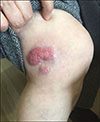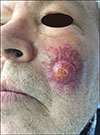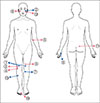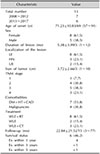1. Coggshall K, Tello TL, North JP, Yu SS. Merkel cell carcinoma: an update and review: pathogenesis, diagnosis, and staging. J Am Acad Dermatol. 2018; 78:433–442.

2. Toker C. Trabecular carcinoma of the skin. Arch Dermatol. 1972; 105:107–110.


3. Hodgson NC. Merkel cell carcinoma: changing incidence trends. J Surg Oncol. 2005; 89:1–4.


5. Ratner D, Nelson BR, Brown MD, Johnson TM. Merkel cell carcinoma. J Am Acad Dermatol. 1993; 29:143–156.


6. Tilling T, Moll I. Which are the cells of origin in merkel cell carcinoma? J Skin Cancer. 2012; 2012:680410.

7. Albores-Saavedra J, Batich K, Chable-Montero F, Sagy N, Schwartz AM, Henson DE. Merkel cell carcinoma demographics, morphology, and survival based on 3870 cases: a population based study. J Cutan Pathol. 2010; 37:20–27.


8. Youlden DR, Soyer HP, Youl PH, Fritschi L, Baade PD. Incidence and survival for Merkel cell carcinoma in Queensland, Australia, 1993-2010. JAMA Dermatol. 2014; 150:864–872.


9. Robertson JP, Liang ES, Martin RC. Epidemiology of Merkel cell carcinoma in New Zealand: a population-based study. Br J Dermatol. 2015; 173:835–837.


11. Liang E, Brower JV, Rice SR, Buehler DG, Saha S, Kimple RJ. Merkel cell carcinoma analysis of outcomes: a 30-year experience. PLoS One. 2015; 10:e0129476.

12. Pilloni L, Manieli C, Senes G, Ribuffo D, Faa G. Merkel cell carcinoma with an unusual immunohistochemical profile. Eur J Histochem. 2009; 53:e33.

13. Harms KL, Healy MA, Nghiem P, Sober AJ, Johnson TM, Bichakjian CK, et al. Analysis of prognostic factors from 9387 Merkel cell carcinoma cases forms the basis for the new 8th edition AJCC staging system. Ann Surg Oncol. 2016; 23:3564–3571.


14. Rødgaard JC, Heje JM, Stolle LB. Merkel cell carcinoma: a single-centre experience. Eur J Plast Surg. 2014; 37:417–422.

15. Agelli M, Clegg LX. Epidemiology of primary Merkel cell carcinoma in the United States. J Am Acad Dermatol. 2003; 49:832–841.


16. Oh SI, Jin US, Chang H, Kwon ST, Minn KW. A retrospective analysis of eight cases of Merkel cell carcinoma. Arch Craniofac Surg. 2013; 14:41–45.

17. Hohaus K, Köstler E, Schönlebe J, Klemm E, Wollina U. Merkel cell carcinoma--a retrospective analysis of 17 cases. J Eur Acad Dermatol Venereol. 2003; 17:20–24.

18. Kukko H, Böhling T, Koljonen V, Tukiainen E, Haglund C, Pokhrel A, et al. Merkel cell carcinoma-a population-based epidemiological study in Finland with a clinical series of 181 cases. Eur J Cancer. 2012; 48:737–742.


19. Lyhne D, Lock-Andersen J, Dahlstrøm K, Drzewiecki KT, Balslev E, Muhic A, et al. Rising incidence of Merkel cell carcinoma. J Plast Surg Hand Surg. 2011; 45:274–280.


20. Koljonen V, Böhling T, Granhroth G, Tukiainen E. Merkel cell carcinoma: a clinicopathological study of 34 patients. Eur J Surg Oncol. 2003; 29:607–610.


22. Bajetta E, Celio L, Platania M, Lo Vullo S, Patuzzo R, Maurichi A, et al. Single-institution series of early-stage Merkel cell carcinoma: long-term outcomes in 95 patients managed with surgery alone. Ann Surg Oncol. 2009; 16:2985–2993.


23. Dancey AL, Rayatt SS, Soon C, Ilchshyn A, Brown I, Srivastava S. Merkel cell carcinoma: a report of 34 cases and literature review. J Plast Reconstr Aesthet Surg. 2006; 59:1294–1299.

24. Cirillo F, Vismarra M, Cafaro I, Martinotti M. Merkel cell carcinoma: a retrospective study on 48 cases and review of literature. J Oncol. 2012; 2012:749030.

25. Rekhi B, Kane SV, Jambhekar NA. Clinicopathological spectrum of a series of Merkel cell carcinomas diagnosed at a tertiary cancer referral center in India, with current concepts. Ann Diagn Pathol. 2015; 19:341–346.


26. Pectasides D, Papaxoinis G, Pectasides E, Galani H, Razi E, Katodrytis N, et al. Merkel cell carcinoma of the skin: a retrospective study of 24 cases by the Hellenic Cooperative Oncology Group. Oncology. 2007; 72:211–218.


27. Allen PJ, Bowne WB, Jaques DP, Brennan MF, Busam K, Coit DG. Merkel cell carcinoma: prognosis and treatment of patients from a single institution. J Clin Oncol. 2005; 23:2300–2309.


29. Dogu MH, Sari I, Hacioglu S, Degirmencioglu S, Şen N, Keskin A. Two rare diagnoses during chronic lymphocytic leukaemia follow-up: Kaposi's sarcoma and Merkel cell carcinoma. Scott Med J. 2016; 61:60–63.


30. Esen BA, Pinarbasi B, Buyukbabani N, Baykal C, Cizmeci O, Demir K, et al. Merkel-cell carcinoma arising after liver transplantation: a case report. Transplant Proc. 2005; 37:4413–4415.


32. Fitzgerald TL, Dennis S, Kachare SD, Vohra NA, Wong JH, Zervos EE. Dramatic increase in the incidence and mortality from Merkel cell carcinoma in the United States. Am Surg. 2015; 81:802–806.


34. Moll I, Roessler M, Brandner JM, Eispert AC, Houdek P, Moll R. Human Merkel cells--aspects of cell biology, distribution and functions. Eur J Cell Biol. 2005; 84:259–271.

35. Lacour JP, Dubois D, Pisani A, Ortonne JP. Anatomical mapping of Merkel cells in normal human adult epidermis. Br J Dermatol. 1991; 125:535–542.


36. Moll R, Moll I, Franke WW. Identification of Merkel cells in human skin by specific cytokeratin antibodies: changes of cell density and distribution in fetal and adult plantar epidermis. Differentiation. 1984; 28:136–154.


38. Higaki-Mori H, Kuwamoto S, Iwasaki T, Kato M, Murakami I, Nagata K, et al. Association of Merkel cell polyomavirus infection with clinicopathological differences in Merkel cell carcinoma. Hum Pathol. 2012; 43:2282–2291.


39. Tessari G, Girolomoni G. Nonmelanoma skin cancer in solid organ transplant recipients: update on epidemiology, risk factors, and management. Dermatol Surg. 2012; 38:1622–1630.


40. Saxena A, Rubens M, Ramamoorthy V, Khan H. Risk of second cancers in merkel cell carcinoma: a meta-analysis of population based cohort studies. J Skin Cancer. 2014; 2014:184245.

41. Tello TL, Coggshall K, Yom SS, Yu SS. Merkel cell carcinoma: an update and review: current and future therapy. J Am Acad Dermatol. 2018; 78:445–454.

42. Eng TY, Boersma MG, Fuller CD, Cavanaugh SX, Valenzuela F, Herman TS. Treatment of merkel cell carcinoma. Am J Clin Oncol. 2004; 27:510–515.











 ePub
ePub Citation
Citation Print
Print





 XML Download
XML Download